 James Danner
James DannerA well-thought-out tent can create a capacious living space, transforming any small boat into an expedition cruising craft.
Boatbuilding never ends with launching day. Refinements and alterations are a constant source of clever ideas well suited to individual needs, never more so than when a small boat is intended for big voyages. In inclement weather, those with open boats may yearn for the enclosed cabins of sailing yachts or small power cruisers—but on the other hand, the accommodations on most small cruising boats can be confining, even claustrophobic since they are often not much larger than the average backyard doghouse. With an increasing interest in using small boats for adventure voyaging and multi-day sails in company, individual innovators have been discovering the practical uses of custom-built tents, which can provide roomy quarters of a size most small cruising boats would envy. The air is fresh, the view is unparalleled, and with advances in tent poles and supplies, the results can be a joy to a cruising sailor.
In small-boat cruising—particularly under sail—having an absolute destination and schedule can be hazardous. At times, getting into a sheltered cove can be a necessity, but you can’t always count on finding a legal or comfortable place to camp ashore. Being able to stay aboard the boat gives the small-craft sailor the same kind of cruising freedom a yachtsman has. Anchor in the cove, cook your meal, enjoy the twilight, stay dry, settle in with a good book, and be ready for wherever the next day’s adventure might bring.
The elements of what makes a good tent may be as individual as the person setting out and the craft in question. Finland (like Sweden) has the cultural ethic of “every man’s right,” meaning you can camp ashore anywhere so long as you respect the owner’s privacy. But one Finnish camper found that level ground was tough to find. His solution, recounted on page 10, was an adventure setup in which he wheels the boat ashore and uses it as its own tent platform for comfortable nights. In Alaska, as another tent-boater explains on page 15, tenting on board away from shore may be a safety advantage—and that may seem counterintuitive until you are informed that an anchored boat is safely out of range of bears. In Maine, enjoying that last bit of twilight from the cockpit may mean having very effective bug screening.
What do small-boat tents have in common? Good design, practical setup, protection from rain, comfortable sleeping, room enough to avoid claustrophobia, and the freedom of a self-contained lifestyle. One of the best ways in the world to develop a good tent is to look around at what other people have been doing, borrowing ideas that work. For some boats, it might even be possible to simply cut the floor out of an existing land tent and adapt it to the boat—however, sources for tent poles and cloth abound, so the do-it-yourself route can assure a custom fit.
The Finnish Touch
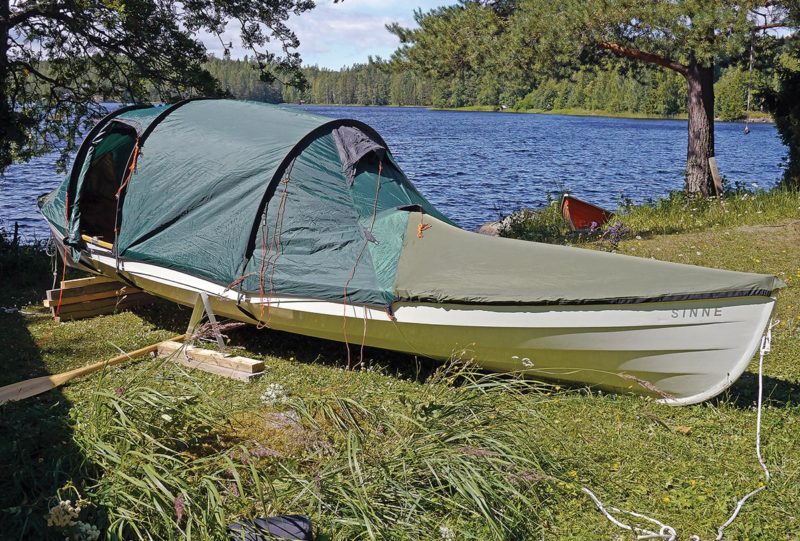 Anthony Shaw
Anthony ShawInstead of seeking level ground, adventuring oarsman Jouko Koskinen worked with designer Ruud Van Veelen to devise a way to level his boat, using side braces and blocking.
by Anthony Shaw
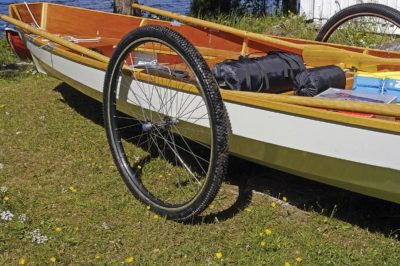 Anthony Shaw
Anthony ShawBicycle wheels fit to the boat hull make the light boat easy to haul out or portage.
Jouko Koskinen is a Finnish architect who had a dream of building a boat that suited both his camping and his boating interests, easy to land from the water and capable of carrying a two- to three-person tent. The design did take nearly 50 years to come to fruition, but it has all the benefits of a well-chewed briar pipestem.
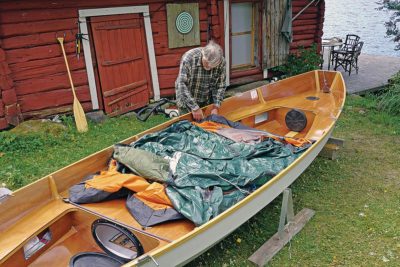 Anthony Shaw
Anthony ShawWith the boat leveled, the off-the-shelf tent sets up quickly.
It was Koskinen’s encounter with Dutch boatbuilder Ruud Van Veelen that crystallized the dream. A scale model was already built and Koskinen had bought a suitable tent when the two met. Van Veelen, the designer and builder of a number of single and double, three- and four-chined rowing skiffs, had little challenge in adapting these to accommodate a two-person tent. The principal difference is the provision of a decked area 2.5m × 1.5m [8′ 3″ ×5′] amidships for the tent.
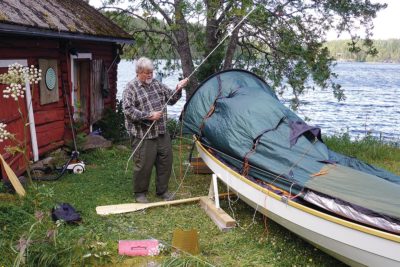 Anthony Shaw
Anthony ShawFor this boat, the tent is meant to be set up while the boat is out of the water, with straps running around the girth of the hull.
The chosen tent, the Halti XPD2, is a three-hoop, two-person, 4 kg [9 lb] expedition tent made of rip-stop polyester, supplied with a cotton inner tent and a waterproof floor. It is well ventilated and has also proved its durability in all-season expeditions. Attachment to the boat is secured with three straps that pass under the boat, locking the tent in place just under the three structural poles. The aluminum poles themselves clip into the eyes of the former internal cross-straps supplied with the tent, which now hang over the sides of the boat, ensuring drainage overboard. The guys attach as usual from the tops of the hoops, but only those stretching to the bow. At the stern, longitudinal stability depends exclusively on Koskinen’s own modification to the rain fly, and in particular on his sewing skill.
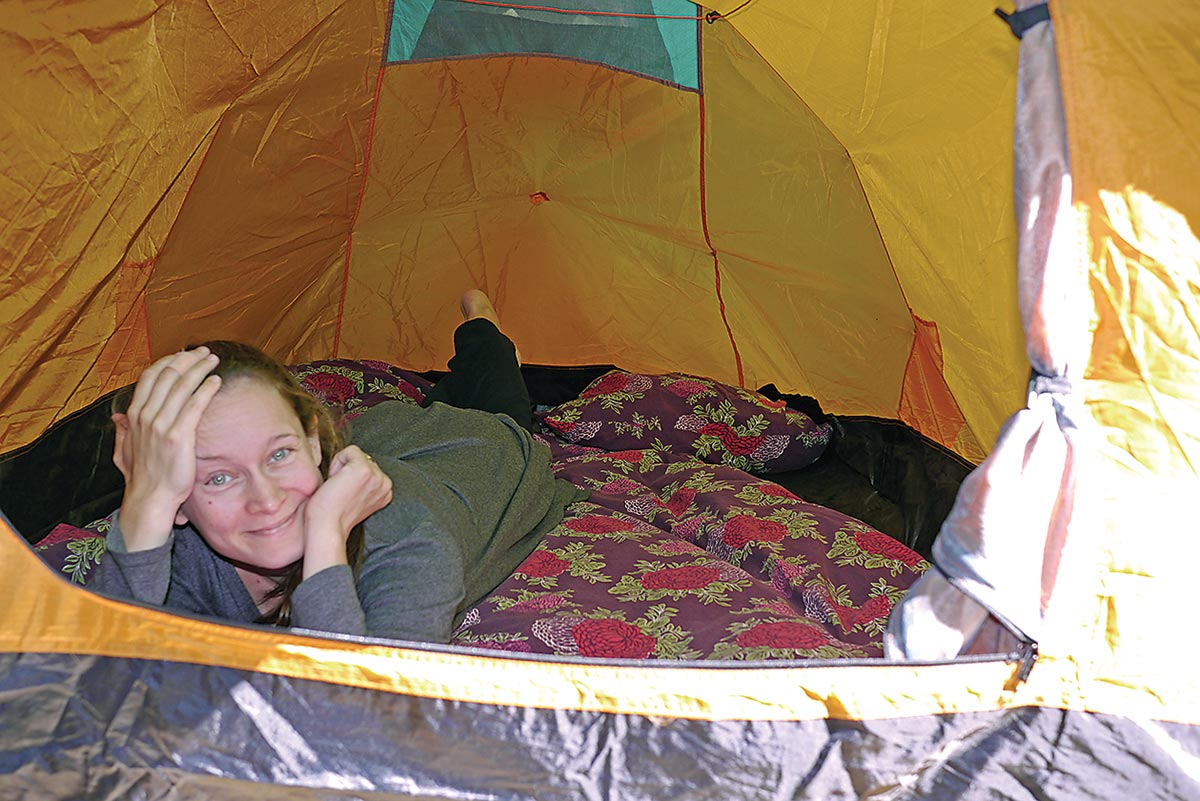 Anthony Shaw
Anthony ShawThe boat’s interior fitout was arranged so that the tent’s large sleeping area would be supported by the central platform, which has storage underneath. The tent door opens to the sitting area.
To provide coverage for the whole boat, the rain fly had to be extended at both ends in order reach the boat’s ends. The material was taken from the rain fly of another Halti tent and was sewn with cotton thread. These extensions are secured outside the gunwale by a shock cord passing through gussets sewn along their edges. In addition to the end fittings, the rain fly is secured by small clips amidships, which also prevent the hoops from slipping too low outside the gunwale.
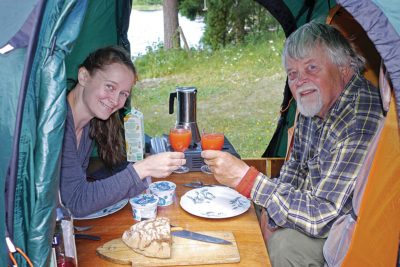 Anthony Shaw
Anthony ShawWith a table mounted in oarlock sockets, the Sinne has a comfortable cockpit from which her crew can enjoy nature and a taste of the good life while protected from the elements.
After beaching the boat via the detachable 36″ wheels, pitching the tent is straightforward. Stabilized at bow, stern, and sides, the boat provides a thoroughly flat and level sleeping area. It would be tricky to set up the tent while the boat is on the water, but Koskinen argues that doing so would defeat the purpose of the boat’s design. The supreme advantage of the Halti XPD2 is access from both sides to the food preparation and storage area, which on the Sinne covers just the area of the rear cockpit. The boat has four open storage lockers at the side, the main watertight compartment under the deck, and a smaller one under the stern. Six small hatches allow access through the central deck. With one’s partner on the facing cockpit seat, some cushioning on the plywood seats, and the meal spread on the table, which fits into oarlock pins, dining is comfortable and compact, and for any backwoods traveler it is as cozy as it ever gets.
A Dory Tent
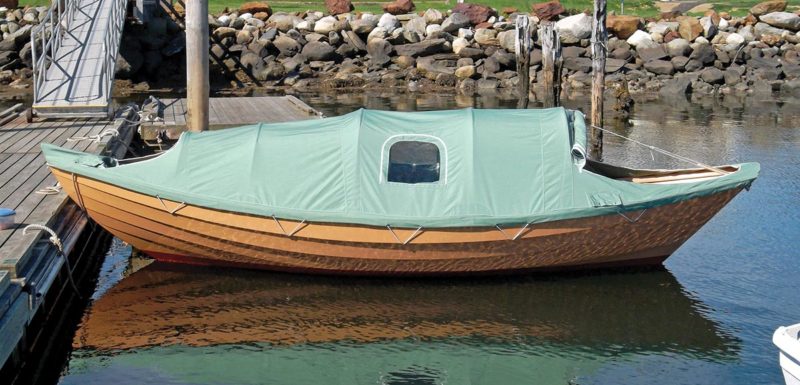 Paul McKinney
Paul McKinneyA fitted tent of Sunbrella fabric, with zippered access panels forward and aft and clear windows at each side, gives a Lowell’s Surf Dory a vast interior volume and good ventilation.
Paul McKinney of Montville, Maine, used a blend of do-it-yourself and professional help to design a tent for his dory. “I often row and cruise an 18′ Surf Dory built by Lowell’s Boat Shop in Amesbury, Massachusetts,” he writes. “Though the dory has no sailing rig or centerboard, she does have a very spacious interior with removable thwarts and a flat bottom, which are ideal features for an effective rowing and cruising boat.
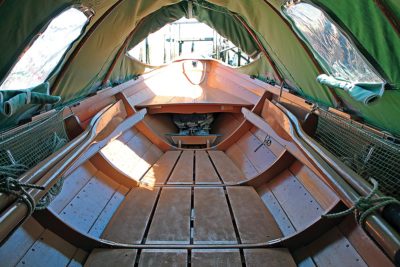 Paul McKinney
Paul McKinneyWith thwarts removed, the interior is large and remarkably clear of obstruction.
“I worked collaboratively with Art’s Canvas of Belfast, Maine, to design a tent structure that would be sturdy in high winds, dry, well ventilated, bug-proof, quickly set, and with a well-lighted interior. The tent, which is fabricated of Sunbrella fabric, is supported by five sprung arches cut from 3⁄4″ CPVC plastic pipe. Before erecting the tent, each arch is slid through a 24″ sleeve stitched to the top interior of the tent.
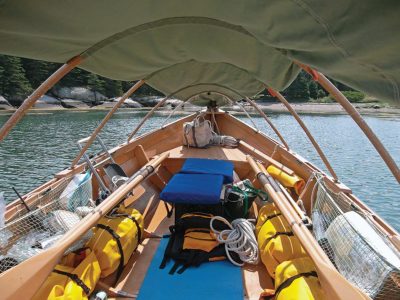 Paul McKinney
Paul McKinneyWith the sides rolled up, the view is unobstructed, and by removing one hoop the boat can even be rowed with the tent blocking the hot sun.
“The method of attaching the bases of the arches to the gunwales is simple and uses readily available parts. There are three rowing stations on this dory, with each oarlock socket being the standard 1⁄2″. Into each socket, I place a 1⁄2″ hitch pin of the type used to secure a trailer hitch in its receiver. The protruding portion of the hitch pin angles at about 45 degrees, turning toward the center of the boat. A short section of plastic hose is pressed over each hitch pin, increasing the diameter to about 5⁄8″. The inside diameter of the arches closely matches the modified hitch pins, resulting in a secure and sturdy attachment when sprung into place.
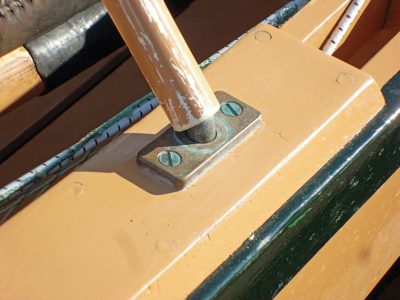 Paul McKinney
Paul McKinneyThe dory tent’s hoop structure uses CPVC pipe supported by fittings set in the oarlocks at the three rowing stations.
“The fore and aft ends of the tent are designed to cover the stem head and transom, respectively, causing the support poles to stand erect with no movement fore and aft. A bungee cord sewn into the lower edges of the tent clips to a series of hooks discreetly fastened just below the sheerstrake lap.
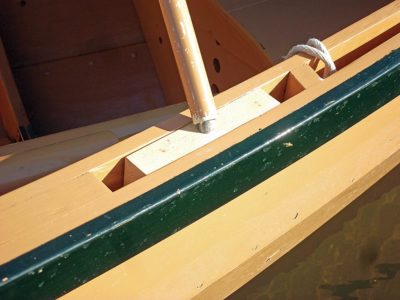 Paul McKinney
Paul McKinneyFor the two intermediate hoops, support fittings slip into the open gunwale.
“Both ends of the tent are designed with semi-circular zippered openings for ventilation, access to the anchor gear, and the creation of a spacious cockpit area in the sternsheets. Additionally, each end has fully zippered insect netting. On each side, amidships, is a generous window with a zippered privacy curtain on the interior.
“If desired, the tent sides can be folded up over each other, creating a very effective sun canopy for rowing on hot, windless days. The arch at the desired rowing station is simply removed from its pin and the hitch pin replaced with oarlocks.
“I have trailered this dory with the tent erected for many hours at speeds in excess of 50 mph without incident. When anchored on a rainy night and a sudden squall blows through, it’s comforting to know that my dory and its contents will remain snug and dry.”![]()
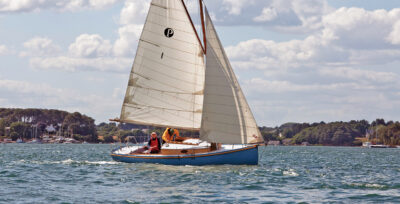
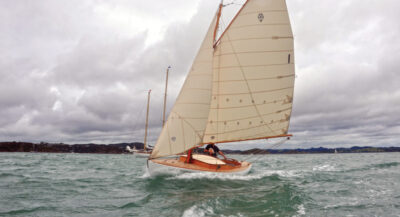
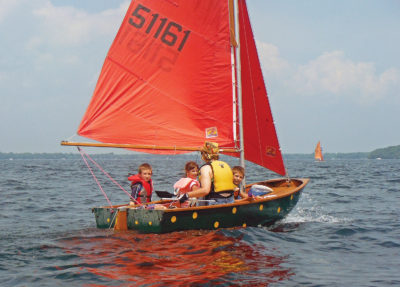
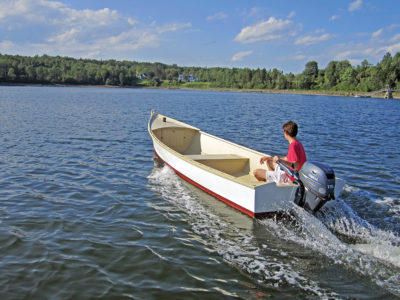
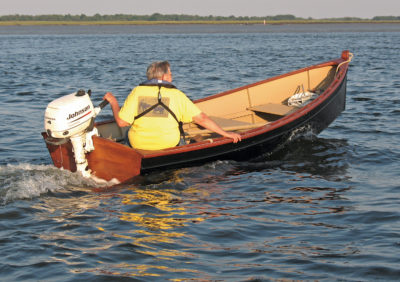
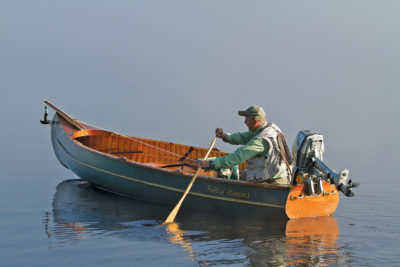
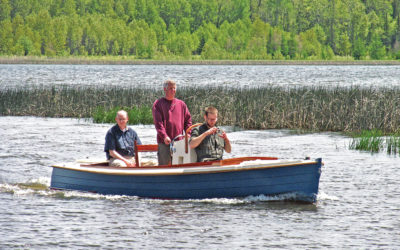
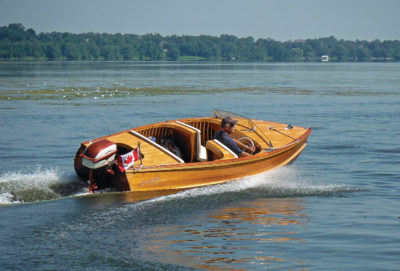
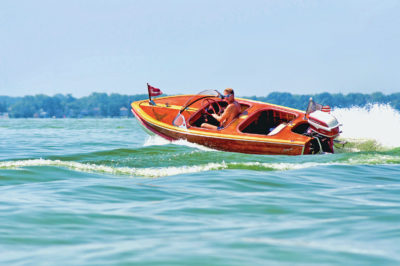
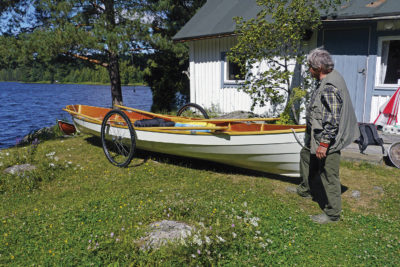
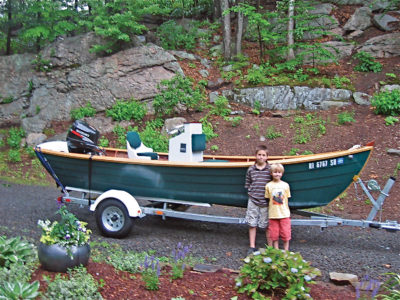
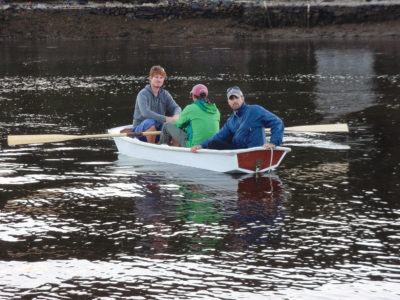
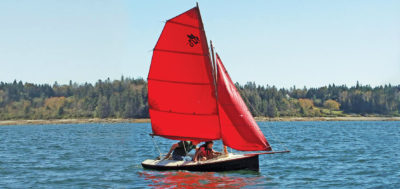
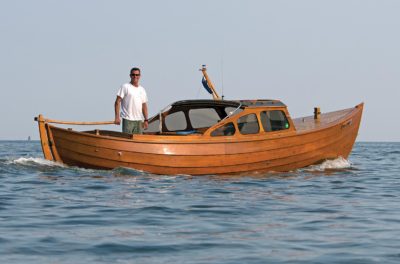
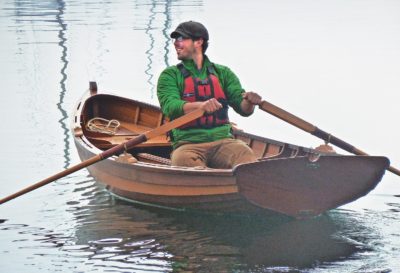
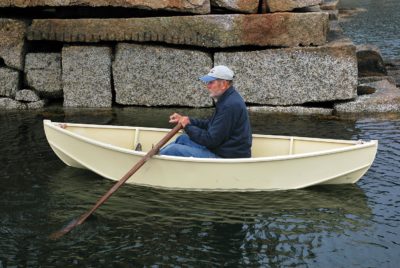
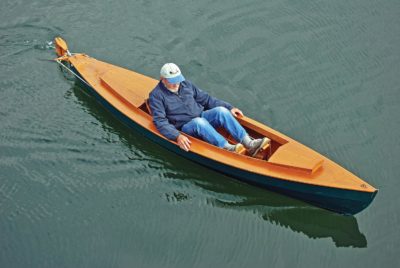
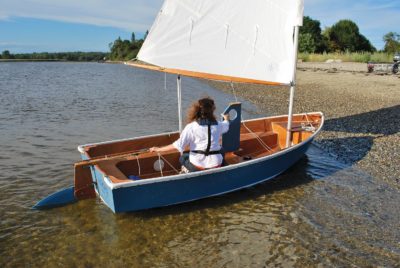
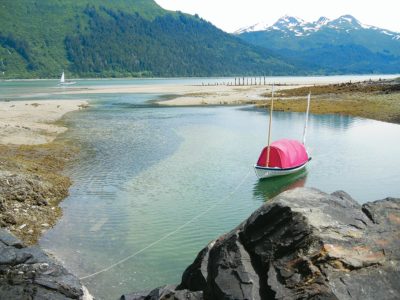
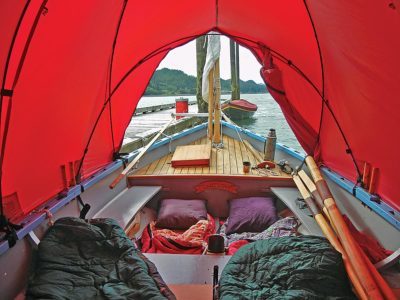
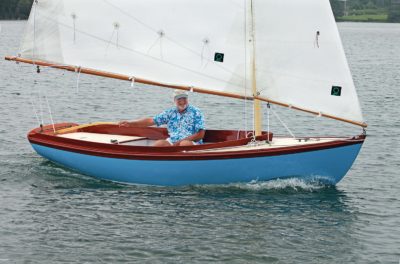
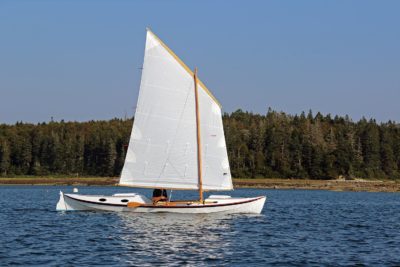
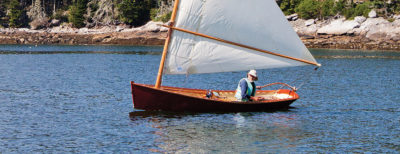
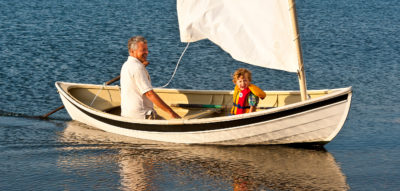


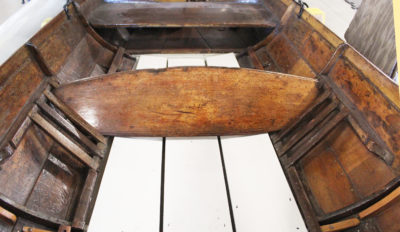

Join The Conversation
We welcome your comments about this article. If you’d like to include a photo or a video with your comment, please email the file or link.